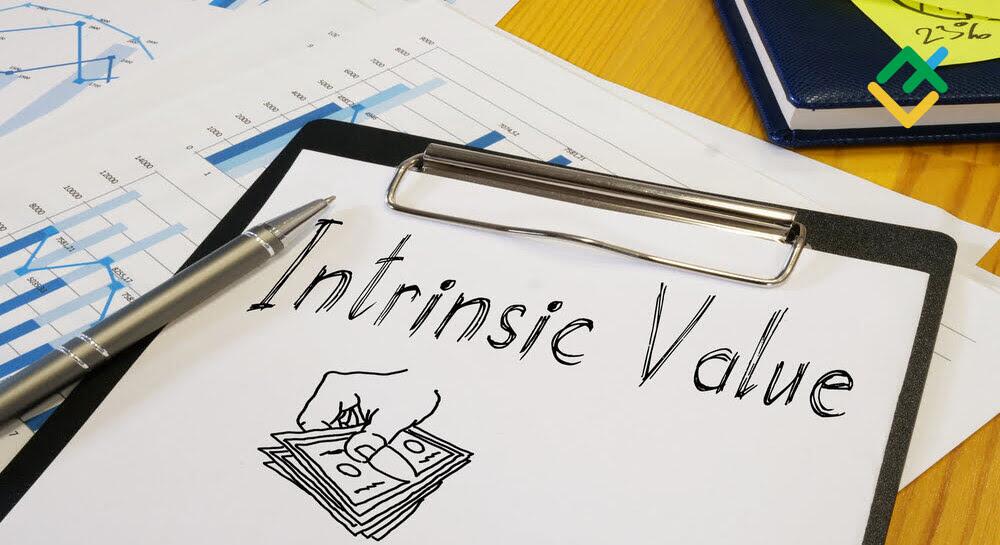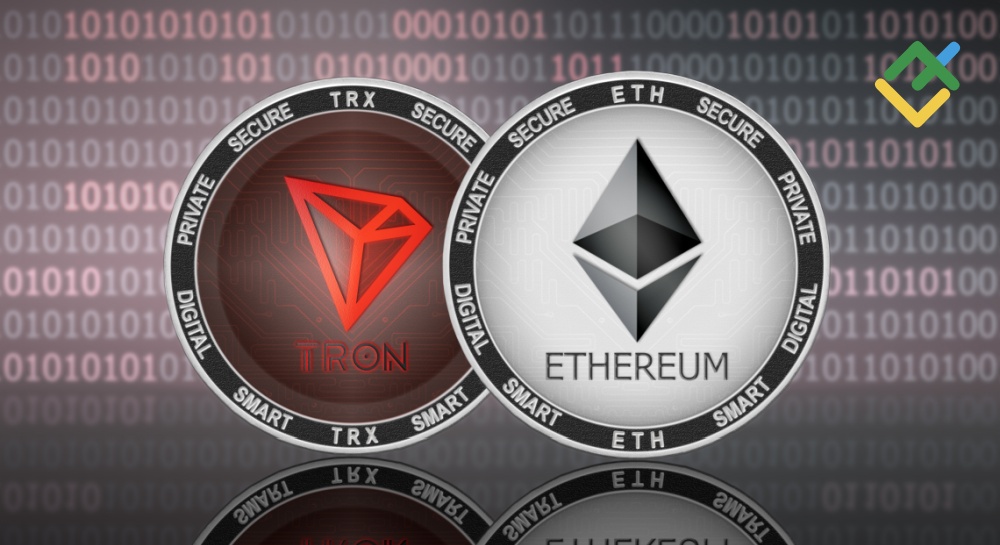
Intrinsic value acts as a crucial gauge for the genuine worth of assets, distinct from their market pricing. This principle helps traders to evaluate an asset’s fundamental value through extensive analysis of anticipated cash flows, the significance of the time value of money, and discount rates. Such evaluations are instrumental in discerning assets’ market alignment with their true worth, guiding well-informed investment decisions.
In this article, we’ll dive deeper into the detailed process involved in calculating the intrinsic value of financial assets, empowering investors with the necessary skills to conduct accurate valuations. Through an in-depth look at methods, examples, pros, and cons readers will learn how to reconcile an asset’s market value with its true value.
The article covers the following subjects:
Key Takeaways
-
Intrinsic value is the true worth of an asset, determined by a mix of number crunching and a deeper look into its underlying characteristics, all without being swayed by its current market price.
-
Tools like discounted cash flow analysis and the Gordon Growth Model play a crucial role in figuring out the real value of financial assets, including stocks and options contracts.
-
Understanding an asset’s intrinsic value is key in spotting whether it’s a bargain or overpriced, helping investors make smart choices.
What Is Intrinsic Value?
Intrinsic value serves as a cornerstone in the realm of investment, representing the inherent worth of an asset detached from its prevailing market price. This valuation leverages both quantitative and qualitative analyses to pinpoint the asset’s true value, a practice particularly embraced by value investors and analysts. To determine the intrinsic value, a comprehensive assessment of factors such as discounted cash flows, present value, and the discount rate is essential. These elements allow for a meticulous calculation that contrasts the current market valuation with the calculated intrinsic worth, providing a clearer picture of an asset’s under or overvaluation.
Furthermore, intrinsic value measures extend beyond stocks to encompass options contracts, where the difference between the stock price and the strike price can offer insights into the option’s real value. This multi-faceted approach ensures a deeper understanding of market dynamics, guiding investors towards more informed decisions that align with the fundamental principles of value investing.
Why Is Intrinsic Value Important?
Intrinsic value is pivotal because it offers a lens through which investors can discern the true worth of an asset, untainted by market volatility and sentiment. This deep dive into an asset’s fundamentals — evaluating everything from cash flows to overall business health — enables investors to make decisions grounded in reality, rather than market noise. By identifying undervalued opportunities or recognizing when to steer clear of overpriced assets, intrinsic value is the cornerstone of sound, value-driven investment strategies, ensuring long-term wealth creation and financial stability.
How to Calculate Intrinsic Value?
Calculating the intrinsic value of an asset is a fundamental aspect of investment analysis, providing a concrete figure that investors use to evaluate whether an asset is worth buying or selling. Various models and methodologies exist to calculate intrinsic value, each suited to different types of assets and investment strategies. This section will explore some of the most widely used methods to give investors a comprehensive toolkit for fundamental analysis.
Discounted Cash Flow Analysis
Discounted Cash Flow (DCF) analysis stands as a cornerstone in determining the intrinsic value of an asset, particularly effective for stocks. By projecting the future cash flows an asset is expected to generate and discounting them to their present value using the weighted average cost of capital (WACC) as the discount rate, DCF analysis offers a thorough valuation.
This method accounts for the time value of money, ensuring that future cash inflows are accurately weighed against their present value. The final step involves summing these discounted flows, providing a valuation that helps investors decide if the current market price justifies the asset’s underlying worth.
Dividend Discount Model
Within the framework of the Dividend Discount Model, the Gordon Growth Model (also known as the Gordon-Shapiro model) offers a streamlined approach for calculating the intrinsic value of a dividend-paying stock, assuming that dividends grow at a constant rate in perpetuity. This model is particularly suited for evaluating companies with stable growth rates in their dividend payouts.
The formula for the Gordon Growth Model is expressed as:
Intrinsic Value = (D0 × (1+g)) / r-g
In this equation, D0 represents the most recent dividend payment, g is the constant growth rate of dividends, and r is the required rate of return or the investor’s desired rate of return. The model simplifies the intrinsic value calculation by focusing on the sustainable growth of dividends, providing a valuable tool for investors to assess the value of stocks with predictable dividend policies.
Asset-Based Valuation
Asset-based valuation takes a more tangible approach, focusing on a company’s balance sheet to determine its intrinsic value. This method involves adding up all of a company’s tangible and intangible assets and then subtracting liabilities to estimate what the business is intrinsically worth. It provides a clear picture of a company’s value based on its physical and identifiable non-physical assets, offering a solid foundation for investors who prefer a more concrete basis for valuation.
Analysis Based on a Financial Metric
Analyzing intrinsic value through financial metrics involves leveraging key financial indicators such as the Price/Earnings (P/E) ratio, Earnings Before Interest and Taxes (EBIT), and Free Cash Flow (FCF) to gauge an asset’s worth.
This approach simplifies the valuation process by focusing on easily accessible financial data, allowing investors to quickly compare an asset’s market price with its perceived fundamental value. While less detailed than DCF or DDM, this method offers a quick and effective way for investors to screen potential investments based on fundamental financial performance.
Start trading with a trustworthy broker
Risk Adjusting the Intrinsic Value
Adjusting the calculated intrinsic value for risk is crucial in providing a more accurate valuation. There are two main methods to incorporate risk considerations:
-
Using a Risk-Adjusted Discount Rate. This approach involves adjusting the discount rate to reflect the risk profile of the asset. A higher discount rate is used for assets with higher risk, effectively lowering the present value of future cash flows and thus the intrinsic value. This method is favored by analysts and value investors for its simplicity in adjusting for risk while calculating discounted cash flows.
-
Assigning a Probability/Certainty Factor. Another method is to adjust the projected cash flows directly by assigning a probability or certainty factor to them, reflecting the likelihood of those cash flows materializing. This nuanced approach allows for a more detailed risk assessment, particularly useful when dealing with options contracts or assets in volatile markets.
Intrinsic Value of Options Contracts
In the realm of derivatives, the intrinsic value of options contracts serves as a fundamental measure to determine if an option is “in the money” by comparing the strike price with the current market price of the underlying asset. Specifically, for a call option, the intrinsic value is calculated by deducting the strike price from the current market price of the stock, provided the result is positive. Conversely, for a put option, it is the difference between the strike price and the stock’s market price, again, only if this difference is positive.
It’s important to note, however, that the intrinsic value only accounts for the inherent worth of the option in relation to the price of the underlying asset. It does not factor in the premiums paid for the option or the time value, which can also significantly influence an option’s market value. Analysts and value investors often utilize this measure to assess the immediate financial advantage of exercising an option, excluding the cost of the option itself and any potential future value.
Get access to a demo account on an easy-to-use Forex platform without registration
Example of an Option’s Intrinsic Value
Consider a scenario where an investor holds a call option for a stock with a strike price of $50, and the current market price of the stock is $60. To calculate the intrinsic value of this call option, one would subtract the strike price from the market price, yielding an intrinsic value of $10 ($60 – $50). Similarly, if the investor holds a put option with the same strike price on a stock currently trading at $40, the intrinsic value would be $10 ($50 – $40), reflecting the option’s profitability if exercised immediately.
However, this intrinsic value does not equate to the total profit or loss from the option trade. It doesn’t account for the premium paid to acquire the option or other factors like the time value, which can significantly impact the option’s overall worth. Therefore, while intrinsic value measures the immediate exercise value of an option relative to the underlying asset’s price, it is not a comprehensive indicator of the option’s profitability.
What Are the Pros and Cons of Intrinsic Value?
Evaluating the intrinsic value of an asset is a fundamental aspect of investment analysis, yet it comes with its own set of advantages and disadvantages.
Pros of Intrinsic Value:
-
Objective Valuation. Intrinsic value using discounted cash flow and other models offers an objective basis to evaluate the true worth of an asset, independent of current market conditions.
-
Long-term Perspective. It encourages a focus on long-term value and future cash flows rather than short-term market fluctuations, aligning with the strategy of value investors.
-
Informed Decision Making. By understanding the intrinsic value, investors and analysts can make more informed decisions about buying or selling assets, potentially leading to better investment outcomes.
Cons of Intrinsic Value:
-
Complex Calculations. Determining the intrinsic value involves complex calculations and assumptions about future cash flows, discount rates, and other variables, which can introduce uncertainty.
-
Market Disconnect. The intrinsic value may significantly differ from the market price due to market sentiment, speculative trading, or other factors not accounted for in the intrinsic valuation.
-
Time-Consuming. The process of calculating intrinsic value can be time-consuming and requires a deep understanding of valuation principles, which may not be practical for all investors.
What Are the Other Forms of Valuation?
While intrinsic value plays a crucial role in assessing an asset’s worth, several other valuation methods are utilized by investors and analysts to complement or offer alternative perspectives:
Technical Analysis
Technical analysis diverges from intrinsic value by focusing on price movements, trading volumes, and other market-driven indicators. It seeks patterns or trends in the stock price that may indicate future movements, relying on historical data rather than the fundamental financial performance of the company. This approach is favored by traders looking for short-term opportunities rather than long-term value investing.
Relative Valuation
Relative valuation involves comparing an asset to similar assets or benchmarks within the same industry or sector. Metrics such as the Price-to-Earnings (P/E) ratio, Price-to-Book (P/B) ratio, and other multiples are used to gauge whether a stock is undervalued or overvalued relative to its peers. This method is particularly useful when assessing the current stock price in the context of the market or industry norms.
Cost Approach
The cost approach bases the valuation on the reproduction or replacement cost of the asset. It calculates what it would cost to recreate the asset from scratch, considering the current price of materials, labor, and other factors. This method is often applied in asset-based valuations, particularly for tangible assets, providing a grounded estimate of what investors might be willing to pay based on the asset’s production costs.
Conclusion
In conclusion, calculating an investment’s intrinsic value using projected future cash flows offers a rigorous and insightful approach for discerning an asset’s true worth, diverging from the often volatile current market price. This methodology is a cornerstone of value investing, enabling investors to assess whether an asset is priced in alignment with its fundamental financial performance and future potential.
By incorporating factors such as time value, valuation techniques, and the weighted average cost of capital, investors can make well-informed decisions, ensuring their investments reflect the asset’s inherent value and not just the current stock price or market sentiment.
Platform where traders earn more
Trade on LiteFinance’s high-tech ECN platform and open an account so that beginner traders can copy you. Earn a commission for copy trading and boost your income.
Intrinsic Value FAQs
Intrinsic value is the inherent worth of an asset, determined by calculating its future cash flows and discounting them to their present value, independent of the current market price.
Examples of intrinsic value include the discounted future earnings of a stock, the present value of a bond’s future interest payments, and the net asset value of a company.
Intrinsic value reflects an asset’s inherent worth based on internal factors and calculated future cash flows, while extrinsic value includes external influences like market conditions and sentiment that affect an asset’s price.
The content of this article reflects the author’s opinion and does not necessarily reflect the official position of LiteFinance. The material published on this page is provided for informational purposes only and should not be considered as the provision of investment advice for the purposes of Directive 2004/39/EC.
{{value}} ( {{count}} {{title}} )
This post is originally published on LITEFINANCE.





